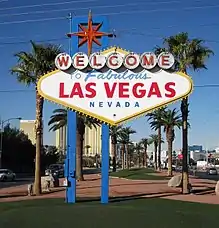RTC Transit
RTC Transit is the name of the bus system in the Las Vegas metropolitan area of Clark County, Nevada. It is a subsidiary of the Regional Transportation Commission of Southern Nevada. While it services most of Clark County with regularly scheduled routes, most of the service is in the immediate Las Vegas Valley; outlying places such as Mesquite and Laughlin provide transit services to their residents via the Southern Nevada Transit Coalition, which uses several vehicles acquired from RTC Transit.
 | |
| Parent | Regional Transportation Commission of Southern Nevada |
|---|---|
| Founded | December 5, 1992 (as Citizens Area Transit) |
| Headquarters | Las Vegas, Nevada |
| Locale | Clark County, Nevada |
| Service area | Southern Nevada: Las Vegas, North Las Vegas Henderson, Boulder City |
| Service type | Bus, bus rapid transit, paratransit |
| Routes | 51 |
| Stops | 3,900+ |
| Stations | 4 |
| Fleet | 408 fixed route 300 paratransit |
| Daily ridership | 178,390 (weekday) |
| Fuel type | Ultra low-sulfur diesel, CNG |
| Operator | Keolis Transit America, MV Transportation, SNTC (fixed-route service), MV (ADA paratransit) |
| Chief executive | M.J. Maynard, CEO |
| Website | rtcsnv.com |

History
Las Vegas Transit
The privately owned Las Vegas Transit System, Inc. ("LVT") provided bus service on the streets of Las Vegas for more than 40 years. LVT service mainly consisted of loop routes that made many turns throughout the city, sometimes doubling back on its own routes and making several "subloops" within a loop. At one point, LVT was named America's worst transit system.
The Regional Transportation Commission of Southern Nevada (RTCSNV or RTC) was formed in 1965 by state legislation to oversee federally-mandated transportation planning in Clark County. Under pressure by the county and state, and by order of the state court, the company was ordered to cease operations except on Route 6-The Strip and relinquish all its city-owned buses to the Regional Transportation Commission of Clark County as of November 15, 1992. LVT and its successors continued to operate service in competition with CAT until about 2005.
Citizens Area Transit era (1992–2008)

Citizens Area Transit was formed by the RTC to provide reliable bus service to the cities of Las Vegas, North Las Vegas, Henderson, Las Vegas Township, Mesquite, and Laughlin. The system began on November 15, 1992 under the direction of Kurt Weinrich, its general manager. Initially the old LVT routes were operated unchanged except for route 6–The Strip, which LVT still retained. The system was totally reconfigured and Strip service begun December 5, 1992. The fleet consisted of mostly old vehicles such as Flxible Grummans, GMC RTSs, TMC RTSs and Gillig Phantoms. They had also purchased 90 new New Flyer D40HFs. The initial route structure was soon seen as deficient and second complete revision was made in June on 1993. Soon after, CAT began to catch on with the city and blossomed. In 1997, the American Public Transportation Association awarded CAT with their highest honor, Best Transit System in America (within its category). However, things began to change in the following years. In 2002, The Amalgamated Transit Union and the bus contractor, ATC, began contract renewal negotiations, but the two sides were unable to reach a compromise on operators' wages and in May of that year, CAT suffered its first strike. Several drivers walked off the job and onto the picket lines, and service had to be suspended on several routes. Coach operators from sister agencies were called in to drive the buses and serve the city before a settlement was reached.
.jpg.webp)
In 2004, CAT received its first shipment of 10 Irisbus Civis bus rapid transit (BRT) vehicles from Irisbus. These buses served on the new Metropolitan Area Express (MAX) route, which serves Nellis Air Force Base via North Las Vegas Boulevard. RTC was a member of the BRT Consortium organized by the Federal Transit Administration (FTA) in 1999. North Las Vegas Boulevard had been restriped in spring 2000, which converted what had been a breakdown lane into a dedicated transit lane; RTC subsequently applied for a federal grant in 2002 under the Bus Rapid Transit Initiative. The Civis featured an optical guidance system (OGS) to automate docking at level-boarding platforms, similar to a light-rail system; however, the OGS proved to be unreliable in service due to the difficulty of maintaining pavement markings. Revenue service on MAX started on June 30, 2004; ridership increased by 25% by the end of 2004, and end-to-end travel times were cut approximately in half, from 50 to 25 minutes.[1]
A year later, CAT received its first shipment of 50 double decker buses from Alexander Dennis. As new vehicles arrived, the RTC started a vehicle replacement program and began to retire its older CAT fleet. In March 2007, CAT received its first shipment of 30 Diesel-Electric Hybrid vehicles from New Flyer. Later that year, an additional 40 double deck vehicles from Alexander Dennis arrived, and the RTC unveiled a new rapid transit system which uses the new Diesel-Hybrid RTV Streetcar from Wright Group. The first line was called the "Gold Line", which serviced the downtown and strip corridors.
RTC Transit era (present)

In late 2007, the RTC began to rebrand the Citizens Area Transit system as RTC Transit. The New Flyer 900 series coaches were the last to be purchased with the CAT logo, and the first to be purchased with the RTC logo. The CAT bus stop signs around the city were replaced by "Transit Stop" signs using the RTC logo. All rider alerts, bus announcements, bus books, and new NABI Hybrid, NABI Diesel and New Flyer CNG buses no longer use the CAT logo.
The RTC received 50 NABI vehicles and the final shipment of 40 42 ft "Deuce" double-deck buses in summer 2008. The RTC also began to receive 45 New Flyer CNG vehicles in late fall 2008. The rebranding was completed on January 1, 2009 when RTC vehicles started featuring "RTC TRANSIT" along with the normal route destination headers. All remaining CAT buses are in the process of retirement or being refurbished to the new RTC gold/blue livery.
In 2007, nine RTC executives received pay raises which averaged 22%. The raises were based on the findings of a consultant, Peter Ronza, who was once employed by Clark County.
The RTC faced serious legal issues in 2008 after several car accidents involving bus shelters occurred. The public demanded that the RTC improve the safety of its shelters, while the RTC stated that there was only so much they could do. The RTC created a Bus Shelter Advisory Committee, and made studies concerning bus stop safety.
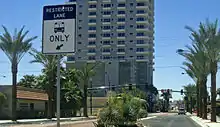
In 2009, the RTC raised bus fares despite public outcry. In 2009 and 2010, proposed bus fares increased from 62% for monthly passes to 100% for full day fare passes. The RTC argued that the fare hikes were due to higher fuel costs, however the largest increase in transit expenditures came from a tripling in capital outlays, rising from $54.5 million in 2007 to $162.9 million in 2009. The price for thirty-day bus passes increased 225% from 1999 to 2010. Ridership was at an all-time high in 2008 due to the very high gas prices, with many people deciding to try transit instead. Ridership numbers declined in 2009 when fuel prices dropped back to reasonable levels, and riders either returned to their own vehicles or began carpooling with co-workers and family.
In January 2010, RTC introduced the ACE branding for its bus rapid transit offerings. The first ACE route was the ACE Gold Line, connecting downtown Las Vegas, the Las Vegas Convention Center, the Strip, and the South Strip Transfer Terminal. In addition, ACExpress was introduced as branding for its express bus service, with an express bus line connecting the Centennial Hills neighborhood northwest of the city with downtown Las Vegas, the Center Strip, and UNLV.[2] In May 2010, RTC rebranded its lines away from the "ACE" name due to a lawsuit from Ace Cab, a local Las Vegas taxi operator; ACE Gold became the Strip and Downtown Express (SDX); ACExpress became Centennial Express (CX), and ACE Green became the Boulder Highway Express (BHX)[3]
The Institute for Transportation and Development Policy (ITDP), under its BRT Standard, has classified the Strip and Downtown Express as a "Basic BRT" corridor.[4]
Future
In 2018, RTC began examining the possibility of installing light rail or enhanced bus rapid transit service along high-ridership routes, particularly the Maryland Parkway corridor.[5][6]
Operations
The RTC currently operates 38 routes with 12 routes operating 24 hours a day, seven days a week, including The Deuce on The Strip. Most routes run from early morning (04:00) until late night (01:00). On weekends & holidays, some routes either operate less frequently, operate with less hours, or not operate at all. Las Vegas has one of the most comprehensive night bus networks in the United States, owing to the 24-hour nature of the casinos and hospitality industry.
RTC Transit is the largest outsourced transit operation in the United States, having overtaken the title from the now-defunct Metropolitan Transportation Authority's Long Island Bus service in late 2011. As of 2011, the contract is worth approximately $600 million over seven years.[7] The fixed route system had been operated by Veolia Transport and its predecessors, ATC-Vancom and National Express, since inception. Bus operators, mechanics, and most other contractor employees are represented by Amalgamated Transit Union Local 1637. Paratransit and dial-a-ride services are operated by First Transit.
The fixed route contract was scheduled to expire September 25, 2011, and was awarded to First Transit, the apparent low bidder and highest scorer on the comprehensive review, however, Veolia has complained to the RTC board of bidding irregularities in the First Transit bid as well as an unfair emphasis on price in comparison to other technical factors. The RTC board approved the First Transit bid on a 4-3 vote, but after the Nevada Attorney General reprimanded the RTC for approving the contract without a majority of the eight members on the RTC board (as opposed to merely those present), which was determined by a district court judge that all 8 members were not required and the award was legitimate. However, in the fallout of the court decision, the RTC returned for a re-vote in which the board then deadlocked at 4-4 for multiple months. The RTC board decided that it was best to cancel the award and bring forward a new fresh proposal for bid, and gave Veolia a 1-year extension while the board found a means to obtain a majority to make a decision. First Transit subsequently sued the RTC to force them to make a decision.[8]
In November 2011 First Transit and the RTC settled their lawsuit. First Transit continued to operate the paratransit system and Veolia continued to operate the fixed route bus system until the end of 2012. The new fixed route transit contract will be split into two, to allow smaller vendors to bid. The two contract system is similar to that of Foothill Transit in the Los Angeles area, which is the third largest outsourced fixed route public transit system in the United States.[9]
In December 2012, the contractors for both yards submitted their 1st round proposals with Veolia, Keolis (no relation to Veolia), and MV Transportation advancing to round 2 and First Transit failing to advance. In January 2013, the remaining contractors submitted their final proposals to the board, and on February 14, 2013, the RTC voted to award the Sunset Maintenance Facility to Keolis, and the Simmons Maintenance Facility to MV, beating out the original two contractors. Keolis and MV began operations of RTC Transit on July 7, 2013 at 12:00am.
MV operates routes 101, 102, 105, 106, 110, 111, 113, 115, 120, 121, 203, 206, 207, 208, 209, 210, 214, 215, 218, 219, 603, 604, 607, CX, & DVX. These routes are primarily in the northern portion of the service area.[10] MV also operates the 700 series (Silver Star) routes. Keolis operates routes 103, 104, 108, 109, 117, 119, 122, 201, 202, 212, 217, 401, 402, 601, 602, 605, 606, 608, The Deuce on The Strip, BHX, & SX. These routes are primarily in the southern portion of the service area.[11] MV also operates RTC Paratransit operations as of March 2020.
Service area
RTC Transit operates a grid-type system within the Las Vegas Valley, which includes the four incorporated cities of Las Vegas, North Las Vegas, Henderson, and Boulder City; in addition, the remaining service area is in unincorporated Clark County under the Las Vegas Township, which includes Enterprise, Paradise (home of the Strip), Spring Valley, Sunrise Manor, Whitney (formerly East Las Vegas) and Winchester. The system's two busiest routes, The Deuce on The Strip and Route 109 Maryland Parkway, provide service to the Las Vegas Strip and McCarran International Airport, respectively. Approximately 40% of Clark County residents do not live within close proximity of a bus stop.
RTC Transit also operates special routes for occasions such as sporting events at Sam Boyd Stadium, T-Mobile Arena, and Las Vegas Ballpark.
Route numbers
- 100s: Local North/South routes.
- 200s: Local East/West routes.
- 300s: "The Deuce" Strip Corridor routes.
- 400s: Regular Shuttle routes.
- 500s: Surface Street Express routes.
- 600s: Special Shuttle routes.
- 700s: Silver STAR routes.
- 900s: Freeway Commuter Express routes.
- FDRs: Flexible Demand Response routes.
RTC Paratransit
Even though all buses in the system have wheelchair lifts, RTC operates RTC Paratransit for people who have difficulty in accessing the regular transit system. By-appointment-only paratransit is a door-to-door service. RTC also maintains an open charge account with a local taxicab company to service paratransit ridership when unforeseen delays occur, frequently caused by traffic congestion.
Fares
The RTC raised its fares in 2009 instead of cutting service, blaming higher fuel costs experienced in 2008 and decreased sales tax revenues.[12] With ridership falling some in 2009, together with the loss in revenue from both the fare box recovery and the state sales tax, the RTC raised fares for a second time. In 2010, the RTC approved another rate hike for the premium service routes only which became effective on January 10, 2010. In 2011, the RTC eliminated purchasing reduced fare passes on The Deuce on The Strip & Strip & Downtown Express (SDX) due to fares being already discounted for locals which became effective on September 11, 2011. Residential 3 day passes were eliminated on September 18, 2011 due to low volume of sales. Residential 5-day passes were eliminated on September 30, 2012 to favor the new 15-day pass. In 2013, the RTC implemented a college pass program, called UPass, with University of Nevada Las Vegas (UNLV), Nevada State College (NSC), & College Of Southern Nevada (CSN) exclusively for the students, faculty, & staff. In 2016, the RTC restored reduced fare options to The Deuce on The Strip & Strip & Downtown Express (SDX) which became effective November 06, 2016.
Fares effective as of November 06, 2016[13]
Fixed routes
| Fare Type | Residential[lower-alpha 1] | Visitor[lower-alpha 1] | |||
|---|---|---|---|---|---|
| Regular | Reduced[lower-alpha 2] | Regular | Reduced[lower-alpha 2] | ||
| Single Ride | $2 | $1 | — | — | |
| Passes:[lower-alpha 3] All-Access (residential)[lower-alpha 1] Strip & All-Access (visitors)[lower-alpha 1] |
2 Hour | $3 | $1.50 | $6[lower-alpha 4][lower-alpha 5] | $3[lower-alpha 4][lower-alpha 5] |
| 24 Hour | $5 | $2.50 | $8[lower-alpha 4][lower-alpha 5] | $4[lower-alpha 4][lower-alpha 5] | |
| 3-Day[lower-alpha 6] | — | — | $20 | $10 | |
| 7-Day[lower-alpha 6] | $20 | $10 | — | — | |
| 15-Day[lower-alpha 6][lower-alpha 7] | $34 | $17 | — | — | |
| 30-Day[lower-alpha 6][lower-alpha 7] | $65 | $32.50 | — | — | |
| Silver STAR[lower-alpha 8] | One-Way | $0.50 | — | — | |
| Transit Guide: | $1 | ||||
| Paratransit Card Holder:[lower-alpha 9][lower-alpha 10] | FREE[15] | — | — | ||
U-Pass: UNLV, NSC, & CSN Student, Faculty, & Staff
Purchased through campus bookstore; provides a 50% discount on monthly passes and a 68% discount on semester passes. Valid on all routes.[16][17]
| Fare Type | Regular[lower-alpha 11] |
|---|---|
| Monthly Pass: | $32.50 |
| Semester Pass: | $104 |
Paratransit
Door-to-door service for riders who are unable to use the fixed-route system.[15] Fares effective as of July 1, 2013:
| Fare Type | Regular |
|---|---|
| Single Ride (one-way) | $3 |
| 4 Single Ride Coupon Booklet | $12 |
| 10 Single Ride Coupon Booklet | $30 |
| 22 Single Rides | $40 |
| 46 Single Rides | $80 |
| Personal Care Attendant | FREE |
- Notes
- The Deuce on The Strip is known as "Premium Service Route" & premium fares only apply to this route. All other routes are known as "Residential Routes" & utilize the general market prices. Visitors to Las Vegas are required to purchase Strip & All-Access passes. Local residents may ride on premium routes with residential fares & all-access passes, but a local ID is required.
- To be able to purchase reduced rides and passes, the RTC requires passengers to present an RTC issued Reduced Fare ID card, RTC issued Veterans ID card, RTC issued Mobility Trained ID card, any reduced fare ID card from any US transit agency, a Medicare card, or a current Clark County School District issued school ID. The RTC does not have a program for low-income workers.
- Multi-hour and multi-day passes are available via RTC app.
- Also available via Ticket Vending Machines (TVM).
- Also available onboard Deuce vehicles.
- Multi-day passes cannot be purchased on vehicles.
- Also available via Ticket Vending Machines (TVM), at Bonneville Transit Center, RTC Administration Building, or various vendors.
- Provides neighborhood loop routes that connect senior living communities with shopping areas and regular fixed-route service.[14]
- ADA Paratransit & RTC Mobility Trained passengers must swipe their RTC issued ID through the farebox when boarding. Mobility Trained passengers must pay fare after swiping ID card.
- All Paratransit card holders and up to 3 children under 6 with fare-paying rider ride for no charge on all fixed routes.
- UNLV/NSC/CSN UPass Monthly & Semester Passes are accepted on all RTC routes & students must show their UNLV, NSC, or CSN student ID's when boarding.
Equipment
RTC currently operates mainly New Flyer, Alexander Dennis and Wright StreetCar RTV coaches for fixed routes, and mainly Ford Econoline vans for paratransit.

On October 27, 2005, CAT added a fleet of double decker buses on The Strip Route. The route is now called The Deuce.
Active
All buses are fully ADA compliant and are 8.5 ft (2.6 m) wide.
| Fleet # (Total ordered) | Year | Model | Image | Length | Fuel type | Engine/ Transmission | Farebox | Headsign | Yard/OC | Comments |
|---|---|---|---|---|---|---|---|---|---|---|
| 011; 013-061 (50 buses) |
2008-2009 | Wright StreetCar RTV | 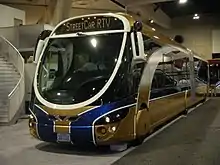 |
62ft | Diesel-electric |
|
SPX Genfare Odyssey | Luminator Horizon (amber) |
|
|
| 151-153; 155-191 (40 buses) |
2008 | Alexander Dennis Enviro500 |  |
42ft | Diesel |
|
GFI Genfare Odyssey | Luminator Horizon (amber) |
|
|
| 350-379 (30 buses) |
2013 | New Flyer C40LFR |  |
40ft | CNG |
|
SPX Genfare Odyssey | Luminator Horizon (white) |
|
|
| 830-844 (15 buses) |
2013 | New Flyer XN60 |  |
60ft | CNG |
|
SPX Genfare Odyssey | Hanover Systems Eric+ (white) |
|
|
| 845-865 (21 buses) |
2014 | New Flyer XN60 |  |
60ft | CNG |
|
SPX Genfare Odyssey | Hanover Systems Eric+ (white) |
|
|
| 15601-15635 (35 buses) |
2015 | New Flyer XN40 | .jpg.webp) |
40ft | CNG |
|
Genfare Fast Fare |
Hanover Systems Eric+ (white) |
|
|
| 15701-15720 (20 buses) |
2015 | New Flyer XN60 |  |
60ft | CNG |
|
Genfare Fast Fare |
Hanover Systems Eric+ (white) |
|
|
| 16601-16630 (30 buses) |
2016 | New Flyer XN40 | .jpg.webp) |
40ft | CNG |
|
Genfare Fast Fare |
Hanover Systems Eric+ (white) |
|
|
| 16701-16725 (25 buses) |
2016 | New Flyer XN60 |  |
60ft | CNG |
|
Genfare Fast Fare |
Hanover Systems Eric+ (white) |
|
|
| 17601-17635 (35 buses) |
2017 | New Flyer XN40 | .jpg.webp) |
40ft | CNG |
|
Genfare Fast Fare |
Hanover Systems Eric+ (white) |
|
|
| 17701-17720 (20 buses) |
2017 | New Flyer XN60 |  |
60ft | CNG |
|
Genfare Fast Fare |
Hanover Systems Eric+ (white) |
|
|
| 18601-18615 (15 buses) |
2018 | New Flyer XN40 | .jpg.webp) |
40ft | CNG |
|
Genfare Fast Fare |
Hanover Systems Eric+ (white) |
|
|
| 18701-18740 (40 buses) |
2018 | New Flyer XN60 |  |
60ft | CNG |
|
Genfare Fast Fare |
Hanover Systems Eric+ (white) |
|
|
| 19601-19620 (20 buses) |
2019 | New Flyer XN40 | 40ft | CNG |
|
Genfare Fast Fare | Hanover Systems Eric+ (white) |
|
| |
| 19701-19715 (15 buses) |
2019 | New Flyer XN60 | 60ft | CNG |
|
Genfare Fast Fare | Hanover Systems Eric+ (white) |
|
||
| 20601-20620
(20 buses) |
2020 | New Flyer XN40 | 40ft | CNG |
|
Genfare Fast Fare | Hanover Systems Eric+ (white) |
|
On Order
All vehicles will be wheelchair accessible.
| Fleet # (Total ordered) | Year | Model | Length | Fuel type | Engine/ Transmission | Farebox | Headsign | Yard/OC | Comments |
|---|---|---|---|---|---|---|---|---|---|
| 2 buses | 2022 | TBD | TBD | Hydrogen Fuel Cell | TBD
|
TBD | TBD | TBD
|
|
Retired
All vehicles were wheelchair accessible.
| Fleet # (Total ordered) | Year | Model | Image | Length | Fuel type | Engine/ Transmission | Farebox | Headsign | Former Yard | Comments |
|---|---|---|---|---|---|---|---|---|---|---|
| 101-105 (5 buses) |
1981 | GMC RTS T8J204 |  |
40ft | Diesel |
|
Luminator |
|
| |
| 101-141 (101-105 2nd) (41 buses) |
2007 | Alexander Dennis Enviro500 |  |
40ft | Diesel |
|
GFI Genfare Odyssey | Luminator Horizon (amber) |
|
|
| 150 (1 bus) |
1983 | GMC RTS T8J204 | 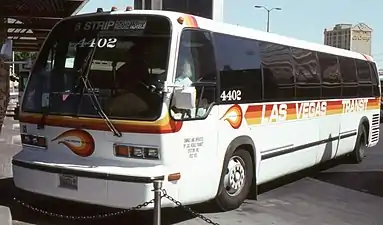 |
40ft | Diesel |
|
Luminator |
|
| |
| 151-152 (2 buses) |
1984 | GMC RTS T8J204 |  |
40ft | Diesel |
|
Luminator |
|
| |
| 153-154 (2 buses) |
1992 | TMC RTS |  |
40ft | Diesel |
|
GFI Genfare CENTSaBILL |
Luminator |
|
|
| 201-208 (8 buses) |
1981 | Grumman Flxible 870 |  |
40ft | Diesel |
|
GFI Genfare CENTSaBILL |
Luminator |
|
|
| 200-249 (201-208 2nd) (50 buses) |
2005 | Alexander Dennis Enviro500 | 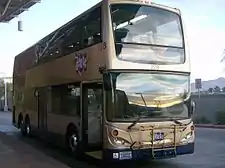 |
40ft | Diesel |
|
GFI Genfare Odyssey | Luminator Horizon (amber) |
|
|
| 250-261 (12 buses) |
1982 | Grumman Flxible 870 |  |
40ft | Diesel |
|
GFI Genfare CENTSaBILL |
Luminator |
|
|
| 301-313 (13 buses) |
1990 | Gillig Phantom |  |
40ft | Diesel |
|
GFI Genfare CENTSaBILL |
Luminator |
|
|
| 300-344 (301-313 2nd) (45 buses) |
2008 | New Flyer C40LFR |  |
40ft | CNG |
|
GFI Genfare Odyssey | Luminator Horizon (amber) |
|
|
| 351-370 (20 buses) |
1997 | ElDorado National Transmark RE |
 |
33ft | Diesel | GFI Genfare CENTSaBILL |
Luminator MAX 3000 |
|
| |
| 380-399 (20 buses) |
1998 | New Flyer D40LF | 40ft | Diesel | Luminator MAX 3000 |
| ||||
| 401-490 (90 buses) |
1992 | New Flyer D40HF |  |
40ft | Diesel |
|
GFI Genfare CENTSaBILL |
Luminator |
|
|
| 500-503 (4 buses) |
1991 | New Flyer D60HF |  |
60ft | Diesel |
|
GFI Genfare CENTSaBILL |
Luminator |
|
|
| 504-509 (6 buses) |
2002 | Neoplan AN460L | 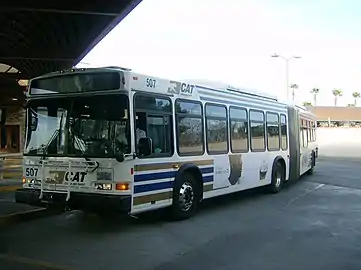 |
60ft | Diesel |
|
GFI Genfare CENTSaBILL |
Luminator MAX 3000 |
|
|
| 510-517 (8 buses) |
1995 | New Flyer D60HF |  |
60ft | Diesel |
|
GFI Genfare CENTSaBILL |
Luminator Mega:MAX |
|
|
| 520-525 (6 buses) |
1996 | New Flyer D60HF | 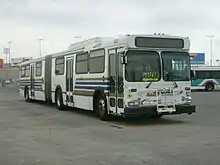 |
60ft | Diesel |
|
GFI Genfare CENTSaBILL |
Luminator Mega:MAX |
|
|
| 530-564 (35 buses) |
1997 | NABI 436.08VA |  |
60ft | Diesel |
|
GFI Genfare CENTSaBILL |
Luminator MAX 3000 & Luminator Horizon (amber) |
|
|
| 565-575 (11 buses) |
1998 | NABI 436.08WA |  |
60ft | Diesel |
|
GFI Genfare CENTSaBILL |
Luminator MAX 3000 & Luminator Horizon (amber) |
|
|
| 601-604 (4 buses) |
1994 | New Flyer D40LF |  |
40ft | Diesel |
|
GFI Genfare CENTSaBILL |
Luminator MAX 3000 |
|
|
| 610-631 (22 buses) |
1995 | New Flyer D40LF |  |
40ft | Diesel |
|
GFI Genfare CENTSaBILL |
Luminator MAX 3000 |
|
|
| 640-657 (18 buses) |
1995 | New Flyer D40LF |  |
40ft | Diesel |
|
GFI Genfare CENTSaBILL |
Luminator MAX 3000 |
|
|
| 670-676 (7 buses) |
2001 | New Flyer C40LF |  |
40ft | CNG |
|
GFI Genfare CENTSaBILL |
Luminator Horizon (amber) |
|
|
| 701-760 (60 buses) |
2001 | NABI 40-LFW (1st Gen) | 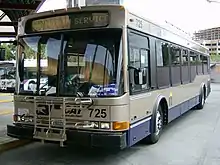 |
40ft | Diesel |
|
GFI Genfare CENTSaBILL |
Luminator MAX 3000 & Luminator Horizon (amber) |
|
|
|
800-829 (30 buses) |
2004 | New Flyer D60LF |  |
60ft | Diesel |
|
Genfare Odyssey | Luminator Horizon (amber) |
|
|
| 900-929 (30 buses) |
2006 | New Flyer DE41LFR |  |
41ft | Diesel-electric |
|
SPX Genfare Odyssey | Luminator Horizon (amber) |
|
|
| 949-978 (30 buses) |
2007 | NABI 40-LFW Hybrid (2nd Gen) | 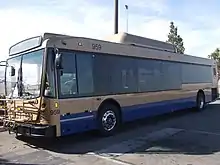 |
40ft | Diesel-electric |
|
GFI Genfare Odyssey | Luminator Horizon (amber) |
|
|
|
979-998 (20 buses) |
2008 | NABI 40-LFW (2nd gen) |  |
40ft | Diesel |
|
Genfare Odyssey | Luminator Horizon (amber) |
|
|
| M01-M10 (10 buses) |
2003 | Irisbus Civis | 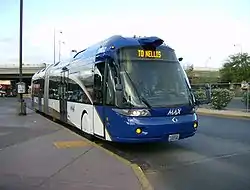 |
60ft | Diesel-electric |
|
SPX Genfare Odyssey | Luminator Horizon (amber) |
|
|
Color schemes

The first livery used was a white base with a teal and magenta mix, black lining around the windows, and the CAT logo in the midsection body, front, and rear. This livery was used from 1992 to 2001.

In 2001, the second livery came in three variants, with the second one being the primary livery. The RTC decided to abandon their teal and magenta, and adopted blue stripes with a cat running on a white base, white around the windows, and moved the CAT logo to just above the first window on either side, under the windshield, and on the engine door (with the exception of the Neoplans which had the logo placed above the rear header). Prior to the arrival of the 2001 New Flyer CNGs and Neoplans, the RTC began repainting the fleet with the blue stripe livery. Once they arrived, the RTC approved a variant to the livery and instead of having just blue stripes, it became blue and gold alternating stripes with the logos in the same positions. The RTC then started repainting coaches with this new variant, leaving the already painted coaches with the 1st variant. This livery was used from 2001 to 2005 on the fixed-route fleet. It is the current livery for the RTC paratransit fleet, using the 2nd variant. Since 2008, a 3rd variant has been used by removing the running cat, having the stripes extend around the vehicle, and replacing the CAT logo with the RTC logo.

In 2004, 10 Irisbus Civis coaches arrived for service on the new BRT line, complete with a new MAX Line livery. It consisted of a blue base, with a white line that stretched the length of the coach, and with gold stars on the rear quarterpanels of each side. This is the current BRT system livery.

In 2005, the RTC again changed the livery and revived the first livery design using the new color scheme and extended the shapes to the bottom of the vehicle. This livery was only used on the 800 series coaches and on coach 654, and it was only used in 2005. A variant of this livery has the CAT logos replaced with RTC fleet logos on the sides of the coach.


Later in 2005, the RTC received its shipment of 50 double deck vehicles, with yet another new livery. This one consisted of an all gold base, with a blue trim around the bottom, and the transit logo between both decks, under the windshield, and under the engine door. Originally to only be used as the livery for the double deckers, the RTC decided it was time to change the livery again, and adopted the livery in 2006. For non-double deck vehicles, the CAT logo remained above the windows, but the RTC logo was added to the position where the CAT logo was in 1992. To date, only 2 vehicles that were already part of the fleet have been repainted in this livery variant (buses 571 and 725). The New Flyer 900 series vehicles were the last vehicles with this livery. In 2008, the RTC made a variant of the livery which had the CAT logo removed and replaced by a special RTC logo only used on these buses. Coach 702 has been repainted with this livery variant. In 2009, RTC commissioned another variant of the livery by replacing the special RTC logo with an "RTC Transit" logo on the sides and front of the coach. "Regional Transportation Commission of Southern Nevada" was placed near the bottom of the coach. New "No Right Turn On Red" and "This Bus Stops At All Railroad Crossings" stickers were placed on the rear. The numbers were moved to the right of the front and rear of each coach, and "www.rtcsnv.com" is placed on the rear either on the destination sign just under the screen or on one of the engine doors.
In 2010, a new livery was commissioned for the BRT system which consists of a gold base with a blue stripe and a white stripe.
Bus terminals
| RTC Transit bus terminals 1 2 3 4 5 6 7 |
South Strip Transfer Terminal
The South Strip Transfer Terminal (or "SSTT"), owned by the RTC, is located just south of McCarran Airport on Sunset Rd. and Gilespie St. The SSTT was opened in 2003 after the Vacation Village hotel and casino was closed, which was the southern terminus for many CAT routes. The SSTT has 18 transit bays that are serviced by 7 RTC routes, Megabus, which began on December 12, 2012, providing service from the SSTT to Los Angeles via Riverside, & BoltBus to Los Angeles. In 2008 the Park & Ride lot was expanded, doubling the amount of spaces available in response to the overwhelming use of the lot by commuters heading to the airport.
- SSTT amenities
- 18 transit bays
- payphones
- restrooms
- security offices
- transit vault
- customer service windows
- waiting room
- vending machines
- ticket vending machines
- "Park & Ride" lot
- "Kiss & Ride" passenger drop-off and pick-up area
- WiFi
- SSTT Bays
- 1 - 109 / Deuce on The Strip (unloading only)
- 2 - 109 / Deuce on The Strip (unloading only)
- 3 - 109 / Deuce on The Strip (unloading only)
- 4 - 217 EB & WB
- 5 - 212 & 217 Overflow
- 6 - 212 EB & WB
- 7 - Not Used
- 8 - Not Used
- 9 - Megabus to Riverside and Los Angeles[18]
- 10 - BoltBus to Los Angeles
- 11 - Amtrak California to Los Angeles
- 12 - Not Used
- 13 - 104 NB
- 14 - Deuce on The Strip NB (loading only)
- 15 - 117 SB
- 16 - 109 Overflow / Silver Rider / Paratransit
- 17 - 122 SB
- 18 - 109 NB (loading only)
Downtown Transportation Center
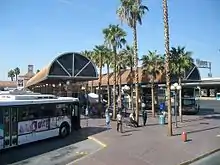
The Downtown Transportation Center (or "DTC") was the main transit center for the RTC systems in downtown Las Vegas. The DTC had 30 numbered bays, and 4 unnumbered bays that serviced 14 RTC routes, and a private Primm employee shuttle route. The DTC was opened in the late 1980s to serve as the main terminal for the Las Vegas City Trolley, and for the private Las Vegas Transit System, Inc. In 1992, it became the terminal for Citizens Area Transit, once Las Vegas Transit ceased operations. Originally, the DTC only had 23 bays, with two of them unnumbered. In 1999, the city expanded the terminal by building a northern plaza which required closing down Mesquite Ave. in the area. The DTC remained under ownership of the City of Las Vegas until July 31, 2009 when the city discontinued their CityRide transit system and transferred control of the terminal to the RTC. The RTC closed the aging terminal on November 7, 2010, with the grand opening of the Bonneville Transit Center.
- DTC amenities
- 34 transit bays
- restrooms
- security offices
- customer service windows
- waiting room
- ticket vending machines
- 1-hour visitor parking
Bonneville Transit Center
.jpg.webp)
The Bonneville Transit Center (or "BTC") is a transit terminal that was built to replace the aging Downtown Transportation Center as the main downtown terminal for local fixed route service. It opened on November 7, 2010 and is located on the corner of Bonneville Ave. and Casino Center Blvd. It has 16 internal bays, 5 external bays, and an air-conditioned lobby for transit riders. The Bonneville Transit Center is served by Deuce On The Strip, Boulder Highway Express (BHX), Centennial Express (CX) and Downtown & Veterans Medical Center Express (DVX). BoltBus to Los Angeles Union Station is accessible on 1st St. @ Bonneville Ave. On December 02, 2018, a new external bay was added.
- BTC amenities
- 21 transit bays
- restrooms
- security offices
- customer service windows
- waiting room
- ticket vending machines
- bicycle racks and lockers
- cyclist showers
- bike repair shop
- RTC Transit Administration offices
- WiFi
- BTC Bays
- 1 - Not Used
- 2 - 105 NB
- 3 - DVX NB
- 4 - 214 EB/214 WB
- 5 - Not Used
- 6 - 206 WB
- 7 - 109 SB
- 8 - 109 SB
- 9 - 604 NB [Special Events]
- 10 - 215 EB
- 11 - 106 NB [106A/106B]
- 12 - 206 EB
- 13 - BHX SB
- 14 - BHX SB
- 15 - 113 NB
- 16 - 113 NB
- 17A - 208 EB & CX NB
- 17B - 207 EB
- 18 - 108 SB, 207 WB & CX SB
- 19 - 401
- 20 - 208 WB
- Transitway on Casino Center Blvd. (NB) – Deuce on The Strip NB
- Transitway on Casino Center Blvd. (SB) – Deuce on The Strip SB
- On Garces Ave. - Primm Employee Shuttle & Silver State Trailways
Centennial Hills Transit Center Park & Ride
The Centennial Hills Transit Center is a transit terminal operated by the RTC to serve the northwest valley and its residents. It includes 900 parking spaces, park & ride, indoor waiting facility, next arrival information and restrooms. Construction began in July 2009, and it opened March 28, 2010 in conjunction with the launch of the ACExpress C-Line (renamed to C-Line Express in May 2010 & Centennial Express in November 2010). The facility is located at Grand Montecito Pkwy. & Elkhorn Rd. Routes that currently serve the Centennial Hills Transit Center are: 106A, 106B, and the Centennial Express (CX).
- CHTC amenities
- 4 transit stops
- restrooms
- security offices
- waiting room
- ticket vending machines
- 900 Park & Ride parking spots
- Park & Ride
- WiFi
- CHTC Bays
- Lot 1 - 106B SB, CX SB
- Lot 2 - 607 SB [Special Events]
- Lot 3 - Not Used
- Ace Blvd. @ Grand Montecito Pkwy. - 106A SB
Westcliff Transit Center
The Westcliff Transit Center is a transit terminal built in the valley's west side community of Summerlin. This terminal is the park & ride for the residents of Summerlin and officially opened on December 12, 2010 in conjunction with the launch of the Westcliff Airport Express (WAX) connecting passengers to McCarran Airport & downtown Las Vegas from the valley's west side.[19] Routes 207, 208 & 209 began service here on November 7, 2010. Route 120 began service here on March 2, 2014. Routes 120, 207, & 209 were removed from here while Route 121 began service here on November 08, 2015. On October 4, 2020 the Westcliff Airport Express was officially discontinued.
- WTC amenities
- 9 transit bays
- restrooms
- waiting room
- ticket vending machines
- Park & Ride
- WiFi
- WTC Bays
- 1 - Not Used
- 2 - Not Used
- 3 - Not Used
- 4 - Not Used
- 5 - Not Used
- 6 - Not Used
- 7 - 208 EB
- 8 - 121 NB
- Durango Dr. @ Westcliff Dr. - 121 SB
UNLV Transit Center
The UNLV Transit Center is a transit terminal built on the University of Nevada, Las Vegas campus in Central Las Vegas. It is located near Maryland Pkwy. & University Rd. & officially opened on September 4, 2013. Route 602 (special event service during UNLV football games only) & Centennial Express (CX) began service here on September 5, 2013. Route 109 is available along Maryland Pkwy.
- UTC amenities
- 6 transit bays
- ticket vending machines
- UNLV
- In & Out Burger
- UTC Bays
- 1 - 602 WB (UNLV football games only)
- 2 - CX SB
- 3 - Not Used
- 4 - 602 EB (UNLV football games only)
- 5 - CX NB
- 6 - Not Used
Downtown Summerlin Transit Facility
The Downtown Summerlin Transit Facility serves Downtown Summerlin as well as Las Vegas Ballpark and City National Arena. It is located at Pavilion Center Drive and Summerlin Centre Drive and opened on October 16, 2017. It serves the Sahara Express and route 206.
Accidents and incidents
- March 9, 2004 (continued to 2016)
On the afternoon of March 9, 2004 Lorraine Macdonald was cycling towards the Fashion Show Mall alongside a CAT Bus. The bus driver failed to look in her rear view mirror and side-swiped Lorraine Macdonald twice, which did not kill her but left her wheelchair-bound with on-going injuries. March 2007, Miss Macdonald took the bus company to court and won the case, however the bus company appealed and the verdict was reversed in the Nevada Supreme Court and another trial ordered. In March 2010, Miss Macdonald went back to court and won the case again which the bus company has again appealed & won.
- July 19, 2006
On the night of July 19, 2006, Alexander Dennis coach 224 on the "Deuce" service was deadheading north on Interstate 15. A tire failed and the bus went through an opening in the median barrier rail that had been removed for construction access. The coach continued through the median and over a barrier on the southbound side of the Interstate. The coach was spinning clockwise when it was hit by a tractor trailer, which caused the bus to spin the other way and collide again with the trailer before coming to a rest. Due to the size of the cleanup, and the need to investigate the accident, the road was not reopened until approximately 10:00 am the following morning. The driver of tractor trailer was killed in the accident. The passenger in the tractor trailer was unrestrained at the time of the accident, and was severely injured. The driver of the coach was severely injured, and partially disabled.
Following the accident, the coach was retained at the RTC Tompkins yard, covered by a giant tarp to preserve it for inspection during the ongoing investigation and litigation. Upon closure of the RTC Tompkins facility, the bus was taken from the facility and moved to an off-site storage location. In 2011, with the investigation over, the bus was moved to the RTC Simmons facility where the bus was finally dismantled for any usable parts & eventually scrapped.
Initial investigation revealed concerns about problems with the tire were reported a few times by drivers prior to the accident. Maintenance records show that each time a problem was reported it was inspected and evaluated by the mechanics. Additionally, the companies involved in the removal of the barrier were also investigated for contributing to the accident.
- January 3, 2008

On the night of January 3, 2008, a CAT bus collided through two brick walls before finally hitting a house. Around 9:30 pm, CAT bus 915 on route 207 was heading south on Christy Lane and turning left onto Mabel Road, when the bus hit a Ford Mustang car. This sent the bus out of control and into the brick walls and the house. There were three minor injuries on the bus, and unconfirmed injuries in the Mustang. The bus was not taken off the property until the next morning, because officials were concerned that the bus might have made the house structurally unsafe. Support columns were placed in the house and the bus was removed.
- March 17, 2008
On the night of March 17, 2008, CAT bus number 653 struck and killed a pedestrian at the intersection of Washington and Rancho.
- July 7, 2008
On the morning of July 7, 2008, A red truck hit the CAT bus stop on Boulder Highway and Flamingo Road, killing 1 woman and seriously injuring another woman. The driver was arrested and officers said he was under the influence of prescription painkillers.
- July 8, 2008
The day following a deadly crash at a CAT bus stop, another incident occurred with a naked man stealing a bus. At around 07:30 hours, Charles Sell was near Washington Ave. and Lamb Blvd, when Metro police reported that, while naked, he stole beers from a 7-11, and then proceeded to steal CAT paratransit vehicle 1792. He punched the door glass, boarded, and took control while the bus driver jumped off for safety. A few hundred metres away, he jumped off while the bus continued in motion. A Metro officer boarded and stopped the vehicle where the suspect Charles Sell was arrested by Metro that landed him for booking into the Clark County Detention Centre on charges of Grand Larceny Auto and Robbery.
- September 13, 2012
On the morning of September 13, 2012, a man in a 2001 Chevy Monte Carlo, crashed into the bus stop at Spring Mountain and Dectaur, killing four, and injuring 8. The impact tore some of the victims to pieces, and hurled some dozens of yards from the point of impact. According to Las Vegas Metropolitan Police Officer Laura Meltzer, it was difficult to determine their identities, but Metro believe all were waiting for the bus. They were identified Thursday night only as three women, ages 65, 49 and 47, plus a 24-year-old man, all of Metropolitan Las Vegas. The man was arrested on suspicion of DUI and was listed in critical condition.[20]
- January 28, 2013
On the afternoon of January 28, 2013, a woman, driving a 2004 Ford Taurus, crashed into a double decker bus at Charleston and Rainbow, killing herself and injuring 5 people who were on the bus. The people of the bus only suffered minor injuries.[21]
- January 9, 2016
On the evening of January 9th, 2016, a 202 bus heading west hit a bus stop sign, near Boulder Highway and Flamingo Road. The bus was pulling in, and hit the bus stop sign off of the shelter, flinging it on the road. Nobody was injured. However, on the same day, around 5 am, a 201B heading east, was pulling up to the curb on Tropicana and Dean Martin Drive. The bus took out the shelter, and doing that, a woman was knocked down and hit by the bus, killing her. (Credit to KTNV 13 for the second story)
References
- Booz Allen Hamilton (August 2005). Las Vegas Metropolitan Area Express Bus Rapid Transit (BRT) Demonstration Project (PDF) (Report). Federal Transit Administration. Retrieved 24 February 2020.
- "RTC to launch new ACE rapid transit services in January". Las Vegas Review-Journal. July 16, 2009. Archived from the original on October 7, 2012.
- Green, Steve (August 17, 2010). "Lawsuit prompts RTC to drop 'ACE' name from bus lines". Las Vegas Sun.
- "BRT Rankings". Institute for Transportation and Development Policy. 2020. Retrieved April 26, 2020.
- "Panel likes light rail line linking key Las Vegas facilities". News3LV. Associated Press. 8 June 2018. Retrieved 5 July 2018.
- Marroquin, Art (25 June 2018). "North Las Vegas leaders envision light-rail line". Las Vegas Review Journal. Retrieved 5 July 2018.
- Adrienne Packer (2011-06-09). "First Transit holds on to bus contract | Las Vegas Review-Journal". Lvrj.com. Retrieved 2013-04-22.
- Adrienne Packer (2011-04-18). "A lot rides on transit contract | Las Vegas Review-Journal". LAS VEGAS REVIEW-JOURNAL - Lvrj.com. Retrieved 2013-04-22.
- Adrienne Packer (2011-11-10). "RTC to re-bid bus contract; First Transit to drop lawsuit | Las Vegas Review-Journal". Lvrj.com. Retrieved 2013-04-22.
- http://www.rtcsnv.com/wp-content/uploads/2012/06/02-14-13-rtc-Item-331.pdf
- http://www.rtcsnv.com/wp-content/uploads/2012/06/02-14-13-rtc-Item-34.pdf
- "Transportation board raises bus fares in 2009, '10". Las Vegas Review-Journal. November 14, 2008. Retrieved 10 February 2020.
- "Ways to Travel: Fares & Passes". RTC Transit of Southern Nevada. Retrieved 10 February 2020.
- "Services for Senior Citizens". RTC Transit of Southern Nevada. Retrieved 10 February 2020.
- "Paratransit and Accessbility". RTC Transit of Southern Nevada. Retrieved 10 February 2020.
- "The RTC is providing discount passes to college students at UNLV, CSN and NSC". RTC Transit of Southern Nevada. September 18, 2019. Retrieved 10 February 2020.
- "Passes For Students". RTC Transit of Southern Nevada. Retrieved 10 February 2020.
- Lindsay William-Ross (2012-11-28). "$1 Express Bus Service From L.A. To Bay Area and Vegas is Back!". LAist. Archived from the original on 2013-03-29. Retrieved 2013-04-22.
- Hansen, Kyle B. (December 11, 2010). "New express bus route to service airport". Las Vegas Sun. Retrieved 24 February 2020.
- Blasky, Mike (2012-09-13). "Four killed as car demolishes bus stop in Las Vegas | Las Vegas Review-Journal". Lvrj.com. Retrieved 2013-04-22.
- Huber, Craig. "Woman killed in wreck with RTC bus ID'd - FOX5 Vegas - KVVU". FOX5 Vegas. Retrieved 2013-04-22.
External links
| Wikimedia Commons has media related to RTC Transit. |
- Regional Transportation Commission of Southern Nevada, owns RTC Transit.
- Keolis Transit America, operates RTC Transit Fixed Route Operations (Sunset).
- MV Transportation, operates RTC Transit Fixed Route Operations (Simmons).
- Veolia Transportation, former operator of RTC Transit Fixed Route Operations.
- Transdev, operates RTC Transit Paratransit Operations.
- First Transit, former operator of RTC Transit Paratransit Operations.
- Southern Nevada Transit Coalition, operator of RTC's routes in Laughlin & Mesquite, as well as the Veterans Medical Transportation Network
- Freeway and Arterial System of Transportation (FAST). Department of RTC responsible for traffic camera system.
